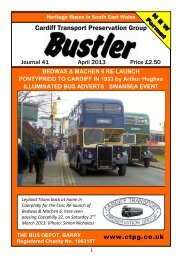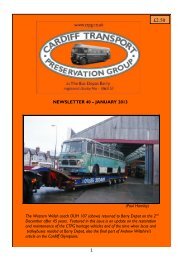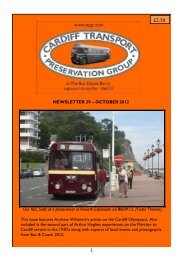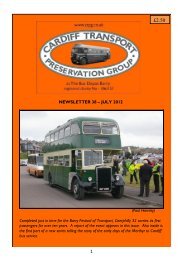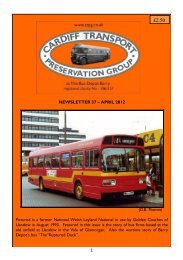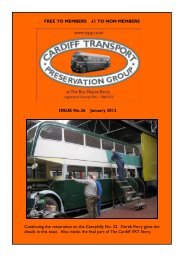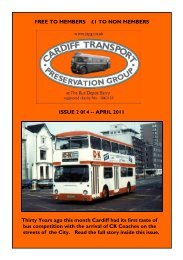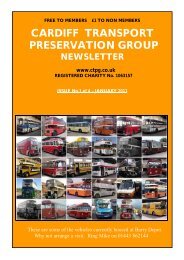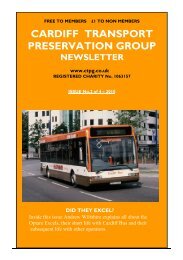2010 – Issue 4 of 4
You also want an ePaper? Increase the reach of your titles
YUMPU automatically turns print PDFs into web optimized ePapers that Google loves.
FREE TO MEMBERS<br />
£1 TO NON MEMBERS<br />
CARDIFF TRANSPORT<br />
PRESERVATION GROUP<br />
NEWSLETTER<br />
www.ctpg.co.uk<br />
REGISTERED CHARITY No. 1063157<br />
ISSUE No.4 <strong>of</strong> 4 <strong>–</strong> <strong>2010</strong><br />
CCT No 385 on training duties. Perhaps the orange livery did not<br />
suit the Regent as well as the later buses. In this issue Andrew<br />
Wiltshire tells the story <strong>of</strong> the Cardiff Regent V’s. (D.G. Bowen)<br />
1<br />
1<br />
1
“We’re <strong>of</strong>f for a pint.” 969 EHW at Bonvilston on our August evening run.<br />
LKG 678 our Regent MkV awaiting further restoration at Barry Depot. (V.C.)<br />
2
CHAIRMAN’S MESSAGE;<br />
Welcome to the final CTPG newsletter <strong>of</strong> <strong>2010</strong>. I think that we should<br />
congratulate Viv on the continuing quality <strong>of</strong> the newsletters this year,<br />
please help to support him through your articles and photos.<br />
The CTPG has purchased another long lasting Welsh coach a former<br />
National Welsh Leyland Tiger with Duple Caribbean bodywork.<br />
This was new as A256 VWO (XC1256) in 4/84 at Cwmbran, then to<br />
Gelligaer St. in 11/84. Re-numbered XC256 in 2/86 and to Aberdare in<br />
3/86. It was then re-registered AAX 305A c. 7/86 and re-numbered as<br />
XC 956 in 2/88. De-licensed 1/91 and sold to Blaengwawr Comp. School<br />
near Aberdare in 11/91. I hope that this coach can be returned to the<br />
road sometime early in 2011 and should allow us to visit some rallies a bit<br />
further away than our normal range.<br />
During December, we will be welcoming AEC Regent V ABW 225D to<br />
Barry Depot. Do not be fooled by the registration, as this is an ex<br />
Kowloon Motor Bus which has been resident at the Oxford Bus Museum<br />
for the last 23 years. A change <strong>of</strong> circumstances at the Museum has<br />
meant this giant will be staying at Barry for a time, hopefully long enough<br />
for it to run at the Barry Rally and to perform a road run next spring.<br />
As we approach the end <strong>of</strong> another year, I would like to thank all those<br />
who keep making the CTPG and the Depot a success, I look forward to<br />
working with you again next year and hope that more <strong>of</strong> the membership<br />
will join us.<br />
On behalf <strong>of</strong> myself and the CTPG Committee, I would like to wish all<br />
our members and readers’ best wishes for 2011 and good fortune in<br />
whatever you do.<br />
See you at the AGM on 19th January 2011 at County Hall 19.30.<br />
Mike<br />
Tel: 07796 265229<br />
Email : mikeystrad73@btinternet.com<br />
Also keep up to date on our Website and Facebook page<br />
3
THE BUS & COACH WALES <strong>2010</strong>;<br />
Over the last several years the CTPG have been fortunate to experience<br />
glorious weather for both the Barry and Merthyr rallies, however the law<br />
<strong>of</strong> averages would see that end. This came true for the fifth Bus & Coach<br />
Wales held at Merthyr Tydfil College on 5 th September <strong>2010</strong>. The rain<br />
meant the absence <strong>of</strong> the open top deckers and a slight drop in the<br />
number <strong>of</strong> visitors. Programme sales were down, but as the group stall<br />
was inside the college we did quite well with the sales <strong>of</strong> photographs.<br />
Those attending were in good spirits and the regular free classic bus trips<br />
to the Brecon Mountain Railway, Rhymney Brewery and the Merthyr<br />
Tour were very popular. Some local lads took the free bus to the<br />
brewery and stayed there. Who can blame them at £1 a pint!<br />
London Transport was represented by the fine RTW 29 <strong>of</strong> the Bristol<br />
Group and RT227 from Aberystwyth and GS63 from Knighton. There<br />
were several buses new to Merthyr this year including Myrddin Jones’s<br />
4
superb former Southdown ‘Queen Mary’ PD3 that proved very popular<br />
on the free trips.<br />
Also among the new vehicles this year were the Swansea Group’s 1981<br />
Volvo coach in British Coachways livery, Cottrell’s 1974 Bedford YRQ<br />
from the Forest <strong>of</strong> Dean and Martyn Evans’s 1975 YRT, newly painted in<br />
Evans <strong>of</strong> New Tredegar livery.<br />
The CTPG were represented by the Stevenson PD3, PAX 466F, the<br />
Newport Atlantean EDW 68D and N143 NTG the Cardiff Metrorider.<br />
Modern buses were displayed by many <strong>of</strong> the south Wales operators and<br />
once again the event was supported by a goodly number <strong>of</strong> classic cars<br />
and the impressive line-up <strong>of</strong> trucks <strong>of</strong> R.T. Williams etc.<br />
--------------------------------------<br />
MORE ON CARDIFF EXCELS;<br />
Further to the article in the last issue, Glyn Bowen has sent this photo <strong>of</strong> the former Cardiff<br />
Excel R205 DKG owned by Ritchies Transport <strong>of</strong> Auckland, New Zealand. This was<br />
photographed on the 813 route between Takapuna and Davenport Wharf<br />
(Peter Thompson)<br />
-------------------------------------<br />
5
CARDIFF’S BUSES by Andrew Wiltshire;<br />
AEC REGENT V’s<br />
Fleet & reg. numbers: 372-381 (XUH372-381)<br />
382-391 (382-391BUH)<br />
408-419 (408-19 DBO)<br />
AEC Regent Mark V 2D3RV (372-381)<br />
2D3RA (382-391, 408-419)<br />
Engine type:<br />
Transmission:<br />
Brakes:<br />
AEC AV590 9.65 litre <strong>of</strong> 140 bhp<br />
AEC 4-speed synchromesh<br />
372-381 Vacuum (triple servo)<br />
382-391, 408-419 Air (dual circuit -front/rear split)<br />
Body manufacturer: 372-391 East Lancs<br />
408-413 East Lancs<br />
414 -419 Neepsend<br />
Seating layout: H35/28R<br />
Year built: 372-381 1961<br />
382-391 1962<br />
408-419 1963/4<br />
Cost: 372-381 chassis: £2583-12s- 0d<br />
372-381 body: £2841- 0- 0<br />
382-391 chassis: £2530- 17- 8<br />
382-391 body: £2952- 0- 0<br />
408-419 chassis: £2542- 16- 0<br />
408-419 body: £2990- 0- 0<br />
Allocation as new: Sloper Road, Cardiff<br />
Dates <strong>of</strong> withdrawal: 372-381 1973/4<br />
382-391 1974/5<br />
408-419 1979<br />
6
Introduced in 1954, the AEC Regent V reflected changes in thinking that<br />
were sweeping the bus industry in the early 1950s. One primary<br />
consideration amongst manufacturers was the way in which the weight <strong>of</strong><br />
a double-decker could be reduced. A light to medium weight chassis<br />
combined with a specially designed lightweight alloy body would hopefully<br />
return more favourable fuel consumption. It was hoped to achieve a<br />
weight saving in the order <strong>of</strong> around half a ton.<br />
From the outset both a lightweight and heavyweight chassis were made<br />
available. The lightweight designated MD3RV had an AEC AV470 7.68 litre<br />
engine, 4-speed synchromesh gearbox and vacuum brakes. It was<br />
particularly popular with BET fleets. The heavier chassis was fitted with an<br />
AEC A218 9.6 litre engine. It carried the designation D3RV (4-speed<br />
synchromesh, vacuum brakes) or D2RA (monocontrol epicyclic and air<br />
brakes).<br />
CCT 381 at Pentrebane in 1968.<br />
(Mike Street)<br />
The Regent V was launched with a new-look front end arrangement. The<br />
grill was very distinctive and easily recognisable and was the outcome <strong>of</strong><br />
7
seven initial designs. However for those operators who did not favour<br />
this, a traditional exposed radiator layout was introduced. This latter<br />
option was favoured by a few fleets. These included Doncaster<br />
Corporation and initially by Leeds C.T. and City <strong>of</strong> Oxford. As with<br />
most double deck types a number <strong>of</strong> thirty foot version were introduced<br />
in 1956. Both had air brakes, an AEC A218 engine and a choice <strong>of</strong> either<br />
manual gearbox (LD3RA) or epicyclic gearbox (LD2RA). The Regent V<br />
was revised in late 1958 when AEC introduced the AV590 9.65 litre<br />
engine and a new series was established. This change was un<strong>of</strong>ficially<br />
known as the second series Regent V. It would only be available in 8 foot<br />
wide form. Air braked models were available in both 27 and 30 foot<br />
lengths with both epicyclic and synchromesh transmission (2D2RA and<br />
2D3RA). However the vacuum braked model was to be available as a 27<br />
foot chassis with synchromesh gearbox (2D3RV).<br />
The final version <strong>of</strong> the Regent V came about when AEC introduced the<br />
AV691 engine which when installed was surprisingly de-rated to 128bhp.<br />
Chassis codes followed the 3D2RA format. Rather surprising for this time<br />
was that the lightweight chassis was still available with AV470 engine, and<br />
had gained the code 2MD3RA. This tells us that it was a synchromesh<br />
model with air brakes. Pontypridd UDC took a 27 foot pair <strong>of</strong> these with<br />
Willowbrook bodies in 1968, which were very late examples. Douglas<br />
Corporation took the last AEC Regent Vs built in 1969, a pair <strong>of</strong> 27 foot<br />
buses with AV691 engine and Willowbrook forward entrance bodies.<br />
Cardiff and the AEC Regent V;<br />
I suppose that it was no real surprise that Cardiff should try the AEC<br />
Regent V. By the late 1950s it had established itself as a very popular<br />
choice <strong>of</strong> double decker in a vast array <strong>of</strong> fleets large and small and in<br />
both lightweight and normal weight versions. It was quite simply a very<br />
solid reliable bus. The Transport Committee met on July 12 th 1960 to<br />
discuss the purchase <strong>of</strong> new double-deckers for 1960/61. Twelve new<br />
vehicles were originally thought to be necessary. However due to an<br />
increased need for double deckers due to changes on Penarth and Heol<br />
Trelai routes, this was increased to 15. Tenders were thus issued for this<br />
number. The Committee met again on September 29 th and 5 Leyland<br />
PD2A/30 chassis and ten AEC Regent V chassis were ordered.<br />
8
The Leylands were the cheapest at £2340 5s 9d per chassis and were on<br />
course to be delivered as No’s 367 to 371 (XUH367-371). The AEC<br />
Regent Vs were chosen upon the recommendation <strong>of</strong> the General<br />
Manager. They would be vacuum braked with synchromesh gearboxes<br />
(2D3RV).<br />
No. 413 passes Leyland 394 on the 24 route at Waterloo Road.<br />
(CTPG)<br />
Metro-Cammell-Weymann quoted £2644 10s 0d per body and this was<br />
accepted for the PD2As. However the General Manager once again<br />
recommended that the Regent Vs have East Lancs bodies at a cost <strong>of</strong><br />
£2759 0s 0d each. These would be 63 seat and <strong>of</strong> 5-bay construction. East<br />
Lancs then increased the price by £82 in October 1961 which was<br />
subsequently approved by the Finance Committee. Delivery followed on<br />
from the five MCW bodied PD2As, and the AECs arrived as No’s 372 to<br />
381.<br />
The first to arrive was No. 381 on November 15 th followed by 374/6/9 by<br />
the end <strong>of</strong> the month. The others were delivered in the December.<br />
Apparently No. 379 was the first bus in the Cardiff fleet to be delivered<br />
with Formica backed seats. All subsequent batches <strong>of</strong> vehicles (382 on)<br />
9
had this as standard. Following a meeting on September 29 th 1961, a<br />
further ten AEC Regent Vs were ordered for delivery in 1962. Once again<br />
these were recommended by the General Manager, and as before Leyland<br />
had come back with a cheaper tender for the chassis and MCW the<br />
cheapest (and probably ugliest) bodies! The order was approved five days<br />
later but not until after the General Manager had given the reasons for his<br />
choice to the Committee!! Not all plain sailing obviously.<br />
CCT 388 (388 BUH) at Central Bus Station.<br />
(CTPG)<br />
These buses appeared in November 1962 as No’s 382 to 391, but were<br />
however different in that they had Westinghouse air brakes and were the<br />
first batch <strong>of</strong> buses to have fluorescent lighting throughout. The rear<br />
pr<strong>of</strong>ile <strong>of</strong> their bodies was more upright than before. No’s 372 to 381<br />
were more rounded like Daimlers 355 to 360. Also worthy <strong>of</strong> note is that<br />
No’s 383 and 385 had ‘hopper’ style opening side windows. These were<br />
the only two built like this and retained this feature throughout their lives.<br />
Following orders for a batch <strong>of</strong> Leyland PD2As (392-401) and then half a<br />
dozen thirty foot PD3As (402-407) it was time to order some more<br />
buses. A final batch <strong>of</strong> 12 Regent Vs was ordered for delivery in late 1963.<br />
10
Approval for these was given in October 1962. These arrived between<br />
November 1963 and January 1964 as No’s 408 to 419 and were to be the<br />
last vehicles delivered to the Cardiff fleet with single piece front<br />
destination boxes. Subsequent new vehicles had a separate route number<br />
box which made for flexibility in displays and would be operated by the<br />
driver from within the cab.<br />
The final six vehicles in the batch (414 to 419) had bodies completed by<br />
East Lancs subsidiary, Neepsend Coachbuilders. These bodies were<br />
completed at the Neepsend factory in Sheffield using East Lancs frames.<br />
Apart from a few minor paint finish differences these last six were<br />
identical to the rest <strong>of</strong> the batch. No’s 408 to 419 were also the first<br />
buses in the fleet to be fitted with plastic ceilings in both saloons and also<br />
plastic interior panels below the windows and down to seat rail level.<br />
Also <strong>of</strong> note is that No’s 408 to 419 were the first double-deckers<br />
delivered without black lining. The fleet livery had been modified early on<br />
in 1963 but these buses managed to be delivered with a cream band<br />
below the upper deck windows and black front mudguards. Surprisingly,<br />
this was ignored by management and they continued in this fashion until<br />
their first repaints.<br />
In service in Cardiff;<br />
So Cardiff now had a fleet <strong>of</strong> 32 Regent Vs which were all the shorter 27<br />
foot examples with somewhat dated manual gearboxes. Many municipal<br />
fleets by the 1960s specified semi-automatic epicyclic versions <strong>of</strong> the<br />
Regent V. Cardiff remained very traditional in it’s specification for buses.<br />
In service the AEC Regent Vs always had a cheerful look about them. A<br />
bright chrome grill made them quite attractive buses, and their distinctive<br />
AEC sound from the AV590 power unit ensured you could hear them<br />
from afar! From a drivers point <strong>of</strong> view they were very popular vehicles.<br />
Gear changing was easy and they had a really good top speed. They were<br />
however very noisy in the cab and lower saloon. They were noisy on tickover<br />
compared with a Gardner engined Guy for example. A loud<br />
chattering throttle pedal to add to the din in the cab when the driver’s<br />
right foot was otherwise engaged. Hunting at low revs resulted in the<br />
engine being difficult to control in “stop start” traffic queues apparently.<br />
11
As is so <strong>of</strong>ten the case the vacuum braked buses required a lot <strong>of</strong> effort<br />
to stop, whereas the air-braked examples could be a little too responsive.<br />
The Achilles Heel <strong>of</strong> the AV590 was reported to be the injector pipes<br />
which broke frequently resulting in small amounts <strong>of</strong> fuel igniting on the<br />
engine. Another weakness on these buses was heavy right-hand steering,<br />
and they would lean quite heavily on bends as well, with the platform<br />
<strong>of</strong>ten scuffing the road surface. Another peculiarity pointed out to me was<br />
that the clutch pedal could have a nasty habit <strong>of</strong> staying down if you dared<br />
changed gear when negotiating a right hand bend. 416 was renowned for<br />
this. The pedal would return once the bus had straightened up!<br />
CCT 391about to leave for Newport while 418 loads for Bronte Crescent. (G. Lumb)<br />
Later on in life the synchromesh gearbox did not quite live up to its name<br />
and gear changing required a little more care. No. 409 was a bad example.<br />
Mac Winfield’s personal favourites from each batch as a driver were No’s<br />
381, 390 and 415! A number <strong>of</strong> Regent Vs were involved in major<br />
accidents. Three buses had a confrontation with low bridges (378, 389<br />
and 416) and all were rebuilt in the Corporations workshops. They lost<br />
their translucent centre ro<strong>of</strong> panels in this process making them much<br />
12
darker on the top deck. Whilst returning from Whitchurch on a 23 turn<br />
when quite new, No. 374 got hooked up on the jib <strong>of</strong> a crane. No. 415<br />
ended up in a ditch near Castleton whilst working the 30 and managed to<br />
get itself into the South Wales Echo for this stunt!<br />
The Regent Vs were to be found on most City services and were<br />
particularly notable for their appearances on the 30 service to Newport in<br />
the mid to late 1960s. These buses were reputed to have a top speed <strong>of</strong><br />
at least 42mph and the 30 would have been the most likely run on which<br />
to witness this.<br />
To my knowledge all Regent Vs ended up in the final version <strong>of</strong> the<br />
maroon livery with minimal cream by about 1973.<br />
Decline <strong>of</strong> the half cab;<br />
The first examples withdrawn were vacuum braked No’s 373/377 and 379<br />
which went in 1973 as being life expired. The remaining examples <strong>of</strong> this<br />
batch (372/4-6/8/80/1) were taken out <strong>of</strong> service in early 1974 having<br />
been replaced by new Bristol VRTs No’s 586-605. All ten were promptly<br />
sold for scrap to Hartwood Exports <strong>of</strong> Barnsley in May <strong>of</strong> 1974 and<br />
broken up.<br />
The second batch <strong>of</strong> Regent Vs lasted a little longer as some examples<br />
were earmarked for use as service vehicles. Some even saw the orange<br />
paintbrush!! No’s 382/3 and 387-389 were withdrawn in 1974. No’s<br />
382/3 and 390 were to become trainers followed by 385 at a later date.<br />
All with the exception <strong>of</strong> 390 carried orange and white livery for this role.<br />
No. 387 became a rest room for use in the bus station between 1974 and<br />
June 1977 and was painted all over orange. No. 382 then went on to<br />
become a mobile <strong>of</strong>fice/rest room in September 1977, and was <strong>of</strong>ten<br />
based in Central Bus Station. It was sold for scrap in October 1978.<br />
No. 383 continued as a trainer until 1978 and 386 also had a short spell as<br />
a trainer in 1975.<br />
The entire batch had been withdrawn from passenger service by the end<br />
<strong>of</strong> 1975. Only No’s 384/88/9/91 went for scrap without performing any<br />
auxiliary duties. No. 390 was believed to be the last survivor <strong>of</strong> the initial<br />
20 Regent Vs not reaching Barnsley until the summer <strong>of</strong> 1979.<br />
The entire batch (408-419) was to receive the orange and white livery<br />
between June and December 1975, as they were to put in a much longer<br />
period <strong>of</strong> service with Cardiff. All were rebuilt between September 1975<br />
13
and May 1976 with a modified destination layout to enable them to show<br />
separate route numbers. Consequently a few <strong>of</strong> the batch ran in orange<br />
with the old style single piece destination box for a short period!<br />
Following this modification the driver gained control <strong>of</strong> the blinds from his<br />
cab which saved the conductor a job on the upper deck.<br />
For a period between 1973 and 1976 most half cabs that had the old one<br />
piece destination box, had alloy frames fixed to the front nearside lower<br />
saloon window so that route number plates could be dropped in as<br />
required. Part <strong>of</strong> the main destination box was then masked <strong>of</strong>f. Quite an<br />
untidy arrangement in my opinion!<br />
CCT 416 looked a bit shabby by April 1972 (CTPG)<br />
No’s 408 to 419 were to end up putting in nearly sixteen years service<br />
with Cardiff. Pretty impressive! In its final year 419 was lent to Roath<br />
depot for a while to help out. It was the believed to be the only Regent V<br />
to work out <strong>of</strong> Roath. The entire batch was withdrawn in the first half <strong>of</strong><br />
1979. No’s 408/9, 412-4/6 went in the January with 410 and 411 being the<br />
last examples to go in the June when half cab and crew operation finished<br />
in the City.<br />
14
No’s 408/9, 412-419 passed to Way (dealer), Cardiff in June 1979. From<br />
there 408 was bought for preservation by the Cardiff Regent V Group,<br />
whilst the others were resold to Barnsley breakers for scrap. No’s 410<br />
and 411 passed to a Barnsley breaker in January 1980. These were the last<br />
Aces in the fleet, the end <strong>of</strong> an era!<br />
Today No. 408 survives in preservation as the sole example <strong>of</strong> the 32<br />
AEC Regent Vs to operate with Cardiff Corporation Transport Its<br />
owners are the Cardiff Regent V Group. In 2002 No. 408 had its original<br />
destination layout restored by Cardiff Bus and was given a repaint for the<br />
Centenary celebrations that year. It has held a Class 6 PSV since 1994.<br />
In 2008 it arrived at Barry depot where certain renovations are taking<br />
place.<br />
I would like to thank Dave Thomas, Peter Smith, Mac Winfield, Paul<br />
Burgess, Allan Morse, Mike Street and the PSV Circle for their help in<br />
putting this article together.<br />
--------------------------------------<br />
OOPS (4)<br />
Western Welsh 300<br />
(AKG 344) was a<br />
Weymann bodied<br />
Leyland TS8, new to<br />
Bridgend depot in Dec.<br />
1937. It is believed to<br />
have been less than two<br />
years old when this<br />
collision occurred. A<br />
few months later it<br />
returned to Bridgend<br />
where it spent all its<br />
working life until<br />
withdrawal in Oct.<br />
1953.<br />
15
SEPTEMBER MEETING:<br />
This was our annual joint meeting with the South Wales & West branch<br />
<strong>of</strong> the Omnibus Society. The speaker was Noel Davies, the Marketing<br />
and Communications Manager for Newport Transport. We learnt that<br />
Newport Bus has seen recent growth to carry over 7.6 million passengers<br />
annually on 87 buses using 150 drivers. The turnover last year exceeded<br />
£10m. In May this year N.B. was the first Welsh bus operator to launch a<br />
“Smartcard” system enabling a flat fare anywhere. Next year the company<br />
plan to introduce a high-spec six wheel vehicles with an innovative and<br />
informal seating arrangement for the X30 Cardiff service.<br />
After the break, a slide show <strong>of</strong> older Newport buses was presented by<br />
Chris Taylor.<br />
OCTOBER MEETING:<br />
On 20 th October a group <strong>of</strong> about 25 watched a slide show <strong>of</strong> images<br />
taken by Alan Jarvis between 1949 and 1969. There were excellent views<br />
<strong>of</strong> the final years <strong>of</strong> Cardiff trams including the last tram that ran on<br />
20/1/50; also views <strong>of</strong> the Mumbles Railway which closed 5/1/60. More<br />
numerous though, were interesting shots <strong>of</strong> steam railways in the Cardiff<br />
area. Although infirm, Mr. Jarvis attended the meeting and gave some<br />
comments on the photographs. However those at the back <strong>of</strong> the room<br />
could not hear him due to the general hub-bub in the room. Come on<br />
lads, give a thought to those who are not as vocal as yourselves and keep<br />
your chatter until the break.<br />
NOVEMBER MEETING;<br />
Peter Heath <strong>of</strong> Cardiff Bus, the advertised speaker for the November<br />
meeting, unavoidably had to cancel due to work commitments.<br />
Our own Peter Smith stepped into the breach to present a selection from<br />
his large collection <strong>of</strong> slides taken over the last half century.<br />
Shown along with the buses <strong>of</strong> Cardiff and Newport were his beloved<br />
trolleybuses. Also very interesting were his evocative views <strong>of</strong> bygone<br />
Cardiff, featuring long gone pubs and cinemas. Peter also likes to include<br />
the odd commercial vehicle which is most welcome.<br />
Altogether it was an excellent evening.<br />
Don’t forget! Our Quiz Night on Wed. 15 th December.<br />
16
TRACING THE LEAK by Paul Burgess;<br />
After a very long time indeed, the leak from Cardiff 585 that trailed an<br />
oily stripe across the Garden <strong>of</strong> England has finally been cured. It took a<br />
few weeks, and much uttering <strong>of</strong> obscenities, but it ran on Sunday 24/10<br />
for about an hour with no signs <strong>of</strong> fresh leakage.<br />
The 'leak' turned out to be two<br />
separate ones, the lesser one having<br />
been masked by the other. The leak<br />
was hard to locate, but was coming<br />
from the side <strong>of</strong> the engine tight against<br />
the bulkhead, and dripping on the<br />
exhaust. Later we narrowed it down<br />
to the modifications made to the<br />
600/680 for use in the Atlantean. Drive<br />
to the fan and alternator on the<br />
Altantean/Fleetline is via a shaft running<br />
behind the engine, powered by extra gears in the timing case. It was the<br />
drive flange mounting for this that was leaking. Later versions also had<br />
provision for a hydraulic pump for power steering. These features were<br />
not on the original 600/680, though a vaguely similar arrangement was<br />
provided using belts for the PD2/3 dynamo drive shaft. In the<br />
Atlantean/Fleetline, the earlier belt driven system would not have coped<br />
with the combined load <strong>of</strong> alternator and fan, though there is a good bet<br />
it was tried on prototypes.<br />
Having examined the job before, we had been putting it <strong>of</strong>f for ages<br />
because <strong>of</strong> appallingly poor access. There are two choices- slumped over<br />
the top and side <strong>of</strong> the engine, and semi upside-down through a hatch<br />
under the back seat! Removing the drive flange revealed a torn gasket,<br />
right next to a pressurised oil drilling; major leak explained! A new gasket<br />
was duly made, and refitting it revealed two critical stripped threads. It<br />
held long enough to show there was a second small leak though!<br />
A bigger dismantling job would be required to get the necessary parts <strong>of</strong>f<br />
for attention. First the timing gear case had to come <strong>of</strong>f, but firstly the<br />
17
crankshaft pulley. This was a tight taper fit, the removal <strong>of</strong> which required<br />
a pr<strong>of</strong>essional hydraulic puller. Dismantling followed fairly quickly, though<br />
one engine mounting had to come <strong>of</strong>f to give clearance to remove the<br />
timing case. With all parts now <strong>of</strong>f, the full extent <strong>of</strong> the problems could<br />
be assessed. Three threads needed repair, plus a number <strong>of</strong> gaskets<br />
needed to be made. Some proper gasket material from the excellent<br />
Sealmasters came in handy- no more dubious backs <strong>of</strong> cornflakes boxes<br />
for me! It all went back together last week, with all (well almost all) <strong>of</strong><br />
the bolts tightening down properly. At the first start it was leaking heavily!<br />
A string <strong>of</strong> expletives turned to relief when a loose banjo bolt in the<br />
pressurised oil feed was discovered and tightened!<br />
Now for a couple <strong>of</strong> weeks on other work while the bruises and sore<br />
fingers heal up. I am sure it would have been easier with the engine out!<br />
The next long standing job is the accelerator hydraulics, and two new<br />
leaks- the axle and power steering fluid!<br />
--------------------------------------<br />
CARDIFF MODEL RAILWAY EXHIBITION;<br />
On the weekend <strong>of</strong> 23/24 October the<br />
group were asked to provide a classic bus<br />
service to the Cardiff Model Railway<br />
exhibition at UWIC on Western Avenue,<br />
Llandaff. 12 trips in all were made with the<br />
Rhondda AEC Regent from the Central<br />
Station. The drivers who gave their<br />
services were Martin Doe, Ian Barlow, Paul<br />
Burgess, Richard Johnson and Alan Jones.<br />
Lee Alder acted as conductor assisted by<br />
Gethin Taylor. The Western Welsh Tiger<br />
Cub <strong>of</strong> Paul Burgess, on display at the College entrance drew admiring<br />
glances. We had a group stall in the college foyer selling books and<br />
models. This, along with a generous donation from the C.M.R. added to<br />
the CTPG funds. Thanks to Paul Gilbertson, Andrew Cremin, Gayle<br />
Alder and Viv Corbin for their assistance on the stall.<br />
18
19
Don’t all rush --- This was 1955!<br />
20
EDITOR’S NOTE ---- NEWSLETTERS FOR 2011;<br />
It is planned to issue four newsletters next year as usual, but to set the<br />
publication date forward one month with issues in January, April, July and<br />
October. This change will have two main advantages. Firstly, reports and<br />
photographs <strong>of</strong> the Barry Rally can appear in the July edition instead <strong>of</strong><br />
September as present. This would apply similarly for the Merthyr event.<br />
It will also ease the load on Mike and me during the lead up to the rallies<br />
to concentrate on the production <strong>of</strong> a good event programme etc.<br />
As <strong>2010</strong> draws to a close, I personally celebrate the receipt <strong>of</strong> a free TV<br />
licence and can’t quite believe it’s exactly 60 years since I left school, so<br />
perhaps the odd spelling mistake can be aloud ---<br />
Too old now to join the politically correct brigade, I’m comfortable living<br />
in the past, the people there know me!<br />
Thanks to those who contributed to the newsletter during the year. No<br />
names! You know who you are! Trying to provide a balanced newsletter<br />
means that some items sit on the shelf for a while, though, let that not<br />
deter anyone from sending in new material.<br />
Readers seem to have been impressed with the quality <strong>of</strong> newsletter<br />
printing recently; this is thanks to Alan and his gang at --------------------<br />
Barry Advertiser Ltd.<br />
“For all your printing needs ring 01446 735452”<br />
This postage stamp shows a 1960<br />
Regent V <strong>of</strong> STCP, the Oporto Bus<br />
Company. This was kindly sent in<br />
by Mr. Ately. Thanks Phil.<br />
Don’t forget our A.G.M. on Wednesday Jan. 19 th 2011 at 19.30.<br />
21
About the CTPG<br />
The CTPG lease the former Western Welsh Depot on Broad Street, Barry from the Vale<br />
<strong>of</strong> Glamorgan Council. The CTPG organises two vehicle rallies each year and holds a<br />
monthly meeting on the third Wednesday<strong>of</strong> each month. Members receive a quarterly<br />
newsletter and if they wish they can help to restore the Group’s buses, ride on them and<br />
travel to rallies.<br />
The Group aims to preserve representative samples <strong>of</strong> the buses that ran in South East<br />
Wales and the Valleys, as well as memorabilia and records <strong>of</strong> the operating companies.<br />
Annual membership <strong>of</strong> the Group is £15, which runs from the date <strong>of</strong> joining. Joint<br />
membership is also available for £25.<br />
CTPG Committee<br />
Chairman<br />
Deputy Chairman<br />
Secretary<br />
Treasurer<br />
Membership Secretary<br />
Mike Taylor, 10 Ger Nant Ystrad Mynach, Hengoed<br />
CF82 7FE Phone;: 01443 862144<br />
email: mikeystrad73@btinternet.com<br />
Chris Taylor, 31 Heol Wen, Rhiwbina Cardiff CF14 6EG<br />
Phone; 029 20693734<br />
Gayle Alder, 16 Carter Place, Fairwater, Cardiff<br />
CF5 3NP<br />
Paul Hamley email: squash33@btinternet.com<br />
Derek Perry, 11 Countess Place, Penarth CF64 3UJ<br />
Other Non Committee Post Holders<br />
Editor Viv Corbin email: viv.corbin@ntlworld.com<br />
Webmaster CTPG Mac Winfield email: postmaster@ctpg.co.uk<br />
Webmaster Bus Depot Matt Turner email: tmatt95@gmail.com<br />
Publicity Officer Nicky Reason email: nickyreason@hotmail.com<br />
www.ctpg.co.uk & www.thebusdepotbarry.org<br />
Published by the Cardiff Transport Preservation Group<br />
(Registered as a Charity No. 1063157)<br />
The opinions and views expressed in this publication are not necessarily those <strong>of</strong> the<br />
Group, its Committee or the Editor. Every effort is madeto give due credit for all<br />
photographs and material used in this newsletter. Should there be any unintended breach<br />
<strong>of</strong> copyright; the Editor must be informed to enable a correcting acknowledgement to be<br />
made.<br />
22
Views from The Bus & Coach Wales <strong>2010</strong> (Paul Hamley)<br />
23
The former Southdown “Queen Mary” attracting the crowds at B&C <strong>2010</strong>. (Ken Angell)<br />
24




